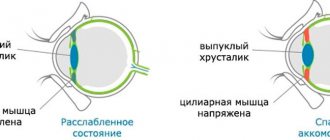Violation of the normal perception of the surrounding world and oneself is a pathological condition, which in medicine is classified as depersonalization. Depersonalization is expressed by a painful feeling of change, lack of unity or loss of the most important personality qualities that are acquired in the process of life experience (character, worldview, value system, life attitudes, etc.). Patients with depersonalization feel that their “I” has completely changed, the old “I” has disappeared, they have lost their spiritual world, they have lost their individuality and independence. As a rule, all patients with depersonalization are prone to “soul-searching” and persistent attempts to figure out “what’s wrong with them.”
In simple terms, depersonalization is a state in which a person feels “changed”, “not the same as before”, “lost some important personality properties”. In extreme, most pronounced cases, he “sees” and evaluates himself from the outside. Often the pathological condition under consideration is referred to as depersonalization-derealization, which implies not only a split personality, but also a violation of the perception of the surrounding world - the patient seems to be inside a virtual game, all the objects and living creatures around him have a flat shape or an unreal color.
At CELT you can get advice from a psychiatrist.
- Appointment with a psychiatrist with an extended interview, psychotherapy session - 4,700
Make an appointment
Causes of depersonalization
Depersonalization-derealization syndrome is a mental disorder that occurs within the framework of:
- neurotic disorders;
- neurological disorders;
- suffered shock (for example, after a serious injury);
- frequent stress;
- schizophrenia;
- manic syndrome;
- depressive syndrome.
The condition in question can be short-term or long-term, and in the latter case, such a mental disorder often leads to suicide. If the depersonalization-derealization syndrome is short-term, then most likely it is triggered by some kind of nervous shock (death of a loved one, trauma, and so on). The short-term course of the condition in question always ends in complete recovery without any consequences, although this may take several months.
Pathogenesis
As a rule, the structure of depersonalization is a protective mechanism during severe emotional stress. In critical situations, depersonalization helps to adequately assess the situation. Under these circumstances, such a reaction is normal. A pathological reaction is considered to be its long course, after the disappearance of the provoking factor.
There is a possibility that the mechanism of development of the disorder is related to the brain's response to stress. Abundant production of endorphins, with high affinity for μ-opioid receptors, leads to activation of these receptors. As a result, the feedback mechanisms necessary to maintain neurochemical homeostasis are disrupted. According to scientists, as a result, the pleasure center is blocked, anhedonia occurs and the limbic system is switched off, because. becomes unable to adequately respond to chaotic stimulation. This mechanism can lead to the appearance of depersonalization-derealization and depressive symptoms.
Studies of emotionally aggressive scenes in people with derealization-depersonalization syndrome have found decreased neuronal activity in the amygdala, an area of the brain associated with emotions.
Derealization-depersonalization syndrome may be associated with improper regulation of the hypothalamic-pituitary-adrenal axis, one of the body's important systems involved in stress responses. People with this syndrome have highly elevated levels of cortisol, one of the indicators of chronic stress.
Symptoms of depersonalization-derealization syndrome
The clinical picture of depersonalization in some cases is quite vivid - complaints sound characteristic and typical for this disorder, and in some cases it is difficult for the patient to determine and express “what is wrong with him,” and the essence of all his complaints will come down to the painful repetition of the phrase “with me.” something is happening, I don’t feel good, something bad happened to me, I don’t understand.” In a conversation with such patients, it is important to correctly formulate questions and be able to identify that element of mental activity, the perception of which is impaired in the patient.
Doctors consider several symptoms of the syndrome:
- A feeling of altered mental processes is a feeling that the information entering the brain, as it were, “encounters a kind of internal barrier and cannot be assimilated in full,” in other words, there is a feeling of impaired perception of information. Trying to express this, patients say that they are “as if covered with a cap,” “placed in a glass flask,” “separated from the environment by an invisible wall.” This may be a feeling of disruption of one or more mental functions (emotions, thinking or activity) - or even all mental activity, which is accompanied by a feeling of “incompleteness of consciousness” and a subjective disturbance in the perception of one’s memories, ideas that lose brightness, seem pale, indistinct, “unreal”. With pronounced depersonalization, there is a feeling of strong alteration or loss of several mental functions or all mental activity, up to a complete loss of the sense of one’s own existence.
- A feeling of altered perception of bodily sensations - obtained through various senses (vision, hearing, various types of skin and other sensitivity), which are expressed, for example, by a feeling of physical emptiness, numbness, mortification in various parts of the body, in more severe cases there is a feeling of complete absence various organs, body parts, body weight, etc. In especially severe cases, a feeling of complete absence of the body may develop, but at the same time, in contrast to depersonalization of mental functions, the feeling of the mental “I” is always preserved.
- A feeling of changes in the perception of the surrounding space - color, volume, contrast: patients complain that the sounds of the outside world are heard muffled, distant or, on the contrary, deafeningly loud, everything seems too bright or, on the contrary, faded, as if it were a set for a film, as if painted, unreal, fake.
People around you may notice disturbances in a person with depersonalization-derealization syndrome of a mental nature:
- he sits in one place and in one position for a long time, as if he has nothing to do and does not need to go anywhere;
- the patient cannot remember what he likes and what he doesn’t (for example, does he like apples);
- lack of desire to lead an active lifestyle - the patient does not wash things, does not clean the house, does not attend work/school.
(Systemic Exercise Intolerance Disease; SEI; Myalgic Encephalomyelitis; ME/CFS)
Chronic fatigue syndrome (CFS) is a state of persistent, lifestyle-related fatigue lasting > 6 months that is unexplained and has a range of associated symptoms. Patient management includes confirmation of disability, treatment of specific symptoms, and in some patients, cognitive behavioral therapy and a gradually increasing exercise program.
Although at least 25% of people consider themselves to have chronic fatigue syndrome (Fatigue), only about 0.5% of people have symptoms that meet the criteria for CFS. Although the term CFS was first used in 1988, the disorder has been fairly clearly described since at least the mid-1700s, but under different names (eg, general malaise, neurasthenia, chronic brucellosis, neurocirculatory dystonia). CFS has been most commonly described among young and middle-aged women, but cases have been reported in all age categories, including children, and in both sexes.
CFS is not malingering (deliberately faking symptoms). CFS shares many of the same symptoms as fibromyalgia, such as sleep disturbances, cognitive decline, fatigue, pain, and worsening symptoms with physical activity.
Classification of the syndrome
In medicine, it is customary to distinguish several forms of depersonalization-derealization syndrome:
- Autopsychic. The patient becomes immersed in himself, he experiences fear and confusion, because he feels that he has changed, is not the same as before, his feelings and thoughts have changed, they are “spoiled”, “unreal”. This type of disease in question is often characterized by the following behavior: reluctance to communicate with friends and family, an external absence of emotional manifestations, complaints of memory loss (incomplete).
- Allopsychic. It is this type of depersonalization syndrome that doctors call derealization - the patient perceives the surrounding reality as a dream or a game/fairy tale. Characteristic signs of such a disorder will be a lack of understanding of one’s location in familiar places, indifference/complete ignorance when meeting a familiar person, problems recognizing people (sometimes they all seem the same to the patient), and the inability to clearly determine the color and shape of objects.
- Somatopsychic. This form is considered the most unusual because patients present strange complaints - for example, they may feel like they are not wearing clothes, or that each part of their body exists separately, and so on. We can say that the somatopsychic type of depersonalization-derealization syndrome is characterized by a pathological perception of one’s own body.
Etiology
Etiology unknown. No infectious, hormonal, immunological, or psychiatric causes have been identified for this disease. It has been proven that among the many infectious agents proposed as causative agents of this disease, neither the Epstein-Barr virus, nor Lyme disease, nor candidiasis, nor cytomegalovirus are the cause of CFS. Allergic markers and immunosuppression were also not identified.
Various minor immunological disturbances have been reported. These abnormalities include low levels of IgG, abnormal IgG, decreased lymphocyte proliferation, low interferon gamma in response to mitogens, low cytotoxic activity of natural killer cells, circulating autoantibodies and immune complexes, and many other immunological abnormalities. However, nothing proposed provides adequate sensitivity and specificity for the detection of CFS. They, however, emphasize the physiological legitimacy of the existence of CFS.
Relatives of patients with CFS have an increased risk of developing the syndrome, suggesting a genetic component or common exposure to environmental pathogens. Recent research has identified several genetic markers that may be associated with susceptibility to CFS. A number of researchers believe that it will eventually be discovered that the etiology of the syndrome may be multifactorial, including genetic predisposition, exposure to microbes, toxins and other physical agents, and/or emotional trauma.
Diagnostic measures
This syndrome is diagnosed based on the patient’s complaints and information from relatives, which describe human behavior characteristic of this disease. No examinations, collection of tests or instrumental examinations make it possible to identify mental abnormalities of the nature in question; on the contrary, people with progressive depersonalization-derealization syndrome look absolutely healthy.
The diagnosis of depersonalization is made clinically - through conversation or semi-structured interview. All additional examination methods are prescribed only in cases where it is necessary to exclude concomitant pathologies.
Complications
Relatively mild complications of the derealization-depersonalization syndrome include the development in the patient of a functional neurocognitive deficit—difficulty in focusing attention on specific tasks or remembering, which often reduces performance and productivity.
If the syndrome is accompanied by mental disorders, they may be resistant to standard treatment.
The importance of depersonalization and derealization is often underestimated. But regardless of concomitant mental disorders, the disorder has a protracted course. When the syndrome occurs against the background of paroxysmal or phasic psychosis, it significantly increases the duration of the attack and increases the risk of a suicide attempt.
General principles of treatment
Depersonalization-derealization syndrome is a mental disorder for which an individual approach is used to treat. If this condition was caused by some kind of nervous shock and is some kind of “protection” of the body after powerful emotional outbursts, then treatment comes down to a course of psychotherapy. After the specialist talks with the patient and assesses his condition, antidepressants and various physiotherapeutic procedures - acupuncture, herbal medicine, soothing massage - can be prescribed. As a rule, with a competent approach to prescriptions, this pathological condition passes without complications, and the patient’s condition is completely restored.
But if the depersonalization-derealization syndrome is protracted and accompanied by suicidal attempts, then such patients need to be treated only in inpatient departments of medical institutions; they are prescribed antipsychotics and tranquilizers in large doses. If such treatment tactics give positive results, and the patient becomes calmer and begins to perceive the world around him in a normal light, then he is prescribed psychotherapy, and all medications are discontinued. Psychotherapists work with such patients for a long time, and even after discharge from a medical institution, they must periodically visit a specialist in order to finally get rid of obsessive, incorrect sensations.
Depersonalization-derealization syndrome is a fairly serious mental disorder that can easily be corrected. If you find these symptoms in yourself or your loved ones, we recommend that you consult a specialist. To clarify the diagnosis and receive qualified medical care, you can contact CELT. This is one of those conditions in the treatment of which our psychoneurologists achieve good results.
Make an appointment through the application or by calling +7 +7 We work every day:
- Monday—Friday: 8.00—20.00
- Saturday: 8.00–18.00
- Sunday is a day off
The nearest metro and MCC stations to the clinic:
- Highway of Enthusiasts or Perovo
- Partisan
- Enthusiast Highway
Driving directions
Diagnostics
In our center, patients with suspected disorders are examined by psychiatrists.
Diagnosis is based on:
- Examination and questioning of patients.
- Identifying characteristic diagnostic signs.
- Purpose of additional studies: EEG, MRI.
During the survey, doctors try to discover the root cause of the disorder. Finding the source of the problem helps solve the question of how to get rid of the deviation. When in doubt, specialists use the method of dynamic observation. This requires hospitalization.
Psychologists provide assistance in diagnosis. They use psychological tests, questionnaires, the Kokoshkarova questionnaire, and Nuller scale assessment. These techniques allow us to establish the intensity, severity and other characteristics of the disorder.
Our specialists accompany the diagnostic process by comparing the disorder with hallucinations and illusions (to exclude the latter).










